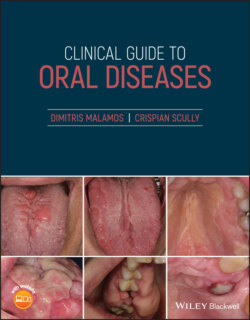Читать книгу Clinical Guide to Oral Diseases - Crispian Scully - Страница 57
Case 4.10
ОглавлениеFigure 4.10
CO: A 58‐year‐old woman presented for an evaluation of some pain from her upper teeth and bad breath.
HPC: The pain was located at the upper molars area and characterized as a constant, dull ache without exacerbations from various cold or hot stimuli. It appeared gradually after a severe cold infection three weeks ago and became associated with a partial loss of smell and taste, as well as bad breath. This was more obvious in the mornings, slightly improved with teeth and mouth cleaning, but remained unchanged with eating.
PMH: She was an overweight lady with no serious medical problems apart from a few episodes of hay fever in spring which were controlled with antihistamine sprays. She was not under any drugs and only a few paracetamol tablets were taken for a flu infection three weeks ago. She had never been a smoker, drinker, or consumer of spicy foods.
OE: The oral examination revealed oral mucosa and dentition in good condition. Despite her heavy restorations (crowns and fillings) her teeth responded well to pulp vitality tests. A slight tenderness around her molars together with stuffy nose, nasal drip secretions and slight cervical lymphadenopathy were seen. A rotten‐like bad breath was detected during the examination. Laboratory investigations revealed hematological and biochemical tests within normal values but sinus X‐rays revealed opacification of the lower third part of both maxillary sinuses (Figure 4.10). The nasal septum and the rest of the visualized sinuses and teeth were normal. A similar episode of pain was reported one year ago and gone with wide broad antibiotics.
Q1 What is the cause of her bad breath?
1 Cystic fibrosis
2 Fungal sinusitis
3 Foreign bodies in maxillary sinuses
4 Sinus malignancies
5 Chronic sinusitis
Answers:
1 No
2 No
3 No
4 No
5 Chronic sinusitis is the cause. Chronic sinusitis is characterized by a chronic infection of the sinuses causing an increased production of mucus with bad odor, which drains down the back of the throat. There, the odor of the infected mucus is intermingled with the exhaled air and causes malodor.
Comments: Halitosis is also detected in deep fungal infections (mainly from Aspergillus or Mucor species) and various sinus malignancies, but these affect a certain group of patients (with immunodeficiencies or with uncontrolled diabetes) and is associated with severe bony and soft tissue destruction. These features are not seen in this patient. Cystic fibrosis is often the cause of antrum infection, but in contrast to this case, is associated with other endo‐bronchial infections, pancreatic insufficiency and intestinal malabsorption. Foreign body in the antrum is usually seen only in one antrum and is often associated with head trauma during surgical or patients' manipulations.
Q2 Which is the major complication of an untreated chronic sinusitis for patient’s life?
1 Infections of surrounding bone or soft tissues
2 Vision problems
3 Loss of smell and/or taste
4 Meningitis
5 Increased risk of sinus malignancy
Answers:
1 No
2 No
3 No
4 Meningitis is very rare, but is the most dangerous complication and caused by the extension of the antral infection to the fluid that surrounds the brain.
5 No
Comments: Uncontrolled infection of the maxillary antrum spreads to the adjacent soft tissues or to the bone causing cellulitis or osteomyelitis respectively. In some cases, infections of the olfactory and optic nerve cause partial or total smell or even vision problems. However, none of the above complications jeopardize the patient's life.
Q3 Which other cause(s) apart from chronic sinusitis is/are not associated with post‐nasal discharge?
1 Allergic rhinitis
2 Acute sinusitis
3 Cold or flu infection
4 Gastroesophageal reflux disease (GERD)
5 Medications
Answers:
1 No
2 No
3 No
4 Gastroesophageal reflux is characterized by acid fluid reflux from the stomach to the throat, leaving the patient with a sense of a lump or post‐nasal sour secretion.
5 No
Comments: Allergic rhinitis, acute sinusitis and flu are characterized by increased production of mucus from the glands of the nose or antra, giving the sense of accumulation of fluid in the throat. Rarely, drugs such as anti‐hypertensives and birth control drugs cause an increased thin clear secretion dropping from the back of nose.
